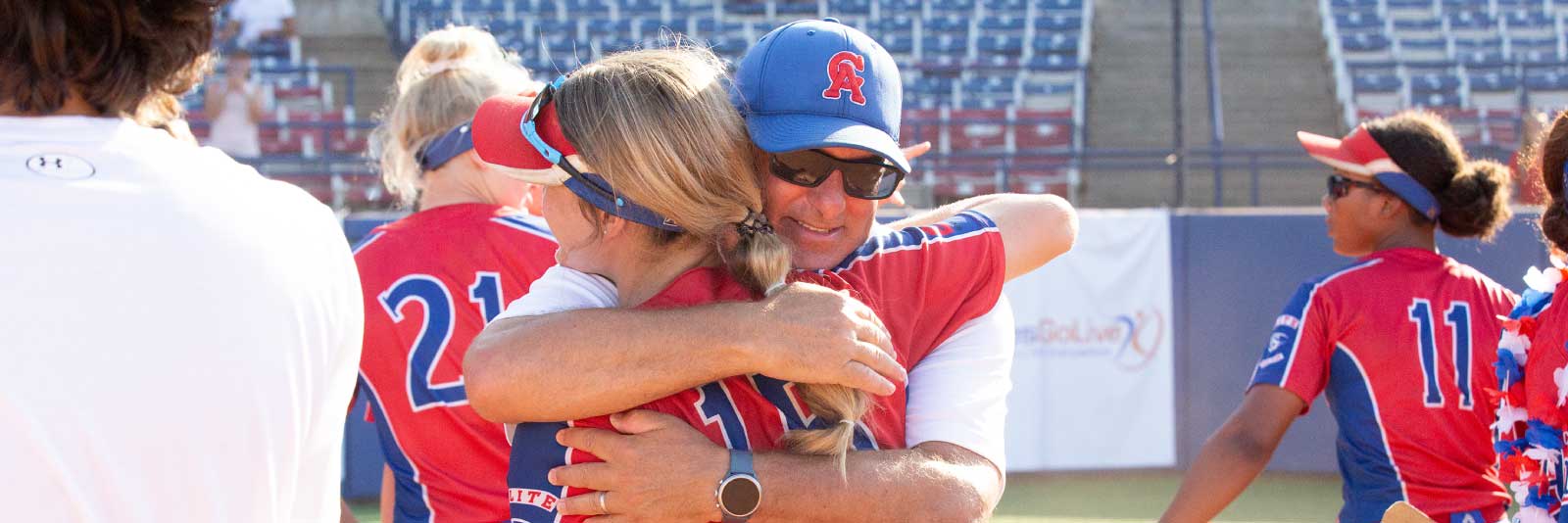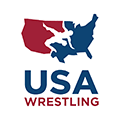How to Get Recruited for Softball

The softball recruiting process is competitive, leaving many families unsure how to get recruited for softball. In fact, only about 8% of high school softball players will compete at the college level, and approximately 1% will play Division 1 ball. To top it off, not all softball players will receive athletic scholarships. In other words, getting recruited for softball—and getting a softball scholarship—isn’t easy. So, what does it take to play college softball? Athletes who have the academics, athletic talent, drive and recruiting know-how can make it to the next level.
To help guide you through the college softball recruiting process, we’ve created the following softball recruiting guide, complete with all the major milestones you need to hit throughout your journey and helpful softball recruiting tips and tricks. The most important softball recruiting tip to remember: Be proactive! Don’t want around for coaches to “find you.” The only way to ensure you get recruited by softball coaches is to take charge of your own recruiting journey.
Quick Links
When does recruiting start for softball?
Softball used to be notorious for starting the recruiting process early, with many prospective student-athletes receiving offers as early as middle school. It was the norm for Division 1 softball coaches to evaluate athletes as young as 7th and 8th grade, and it was not uncommon to see these athletes snag an offer. However, in an effort to curb early recruiting, the NCAA adopted and passed new rules in 2018 that put a stop to this early communication—and early offers. What does this mean for potential softball recruits?
The NCAA prohibits all types of communication and contact between D1 college coaches and prospective recruits before September 1 of an athlete’s junior year. While recruits used to be encouraged to start contacting coaches as early as possible, college coaches at the D1 level cannot finalize their rosters, have recruiting conversations or make any verbal offers to any recruits before this date. This includes private correspondence such as emails, social DM’s, text messages and recruiting letters, as well as phone calls, off-campus contact at a recruit’s school, home, or softball events and even unofficial and official visits.
While this may seem like the end of early recruiting altogether, D1 softball coaches will still be searching for and evaluating prospective softball recruits in other ways. Having a robust online profile, complete with a softball highlight video and academic stats can help younger softball recruits stand out from the crowd and get noticed by D1 college coaches—because despite the new rules, when September 1 of junior year approaches, it’s virtually guaranteed that D1 softball college coaches will already have lists of prospective athletes they want to reach out to—and potentially extend offers to.
D2 coaches used to start their recruiting slightly later than D1 coaches, but now the recruiting timelines are more aligned than ever. The more competitive the D2 program, the earlier they will start scouting athletes. In fact, D2 college coaches can send out emails, texts and social DM’s, call prospective athletes, and have off-campus contact starting June 15 after a recruit’s sophomore year. This gives D2 coaches two and half months longer of a recruiting timeline than their D1 counterparts.
Meanwhile, D3 and NAIA programs, who used to start the recruiting process a little later by reaching out to sophomores and juniors, now have the most lenient recruiting timeline—they’re allowed to contact athletes at any age and conduct off-campus contact immediately after an athlete’s sophomore year. However, D3 college coaches must wait until January 1 of a recruit’s junior year before extending an invite for an official visit. D3 and NAIA programs also have a slightly longer recruiting cycle, as they tend to spend time making sure that their school is the right fit for the athlete academically and socially, as well as athletically.
Softball recruiting tip: If you’re a late bloomer or you get a late start in your recruiting, focus your time on D3, NAIA and NCJAA schools. You might be able to get some last-minute D1 or D2 interest, but it’s much more likely that D3 and NAIA schools still have some open roster spots.
Related Articles
- How to find the ultimate college softball team for you.
Getting started: Level set your talent and expectations
The softball recruiting process starts with you, your family and your current coach. Sit down with your parents and go through the following questions, answering as honestly as possibly:
- Am I ready for the demands of being a college softball player? No matter what division level you compete at, softball is going to take up a lot of your time. There will be early practices, training sessions, games and traveling on top of your classes and homework. Make sure you’re ready for this level of commitment before you dive into the recruiting process.
- Am I good enough to play college softball? Answering this question requires you to critically analyze your current skillset and athleticism, as well as project how much you’ll be able to improve by the time you’re a freshman in college. This is a great time to loop in your current coach to discuss your goals of playing college softball and have an honest conversation about your skill level. You can also get evaluated by a third-party like NCSA. Our staff of former college softball coaches and athletes know exactly what it takes to compete at the college level and can give you key softball recruiting tips to help you find your best college match.
- What division level(s) am I qualified to play at? There are hundreds of opportunities for softball players at the Division 1, Division 2, Division 3, NAIA and junior college levels. Ask your current coach, a qualified third-party like NCSA and college coaches themselves what division levels you might be qualified to compete at. Learn more about the different division levels.
Research schools and create your target list
One of the best softball recruiting tips that we can give: Do your research and cast a wide net when looking at schools! Ideally, you want to start out by contacting a lot of college coaches—think: around 20-30—and then you’ll pare down your list over time. Here’s how we recommend organizing your target list.
- 5 safety schools: These are schools you know you’ll be able to play at, and you qualify academically. Softball recruiting tip: Get in touch with these coaches early on so the coach knows you’re genuinely interested. That way, if one of your target schools falls through, you don’t have to start the recruiting process all over again at the last minute.
- 10 target schools: This is where you’ll put the schools that are your best match—the ones you really want to focus on in your recruiting.
- 5 reach schools: These schools might be out of your price range or very academically or athletically competitive. Add them to your list as a great goal to strive for.
Softball recruiting tip: Always include a mix of division levels in your target list. You might be surprised which division level is right for you, and it maximizes your opportunity to get a college softball scholarship. Check out this list of questions to ask yourself to help you find your best college match.
Create an eye-catching skills video
Of all the softball recruiting tips you’ll find, one of the most important ones is to create a skills video that shows off your hitting, speed, primary position, secondary position and what makes you unique as a softball player. Coach Kalee Patterson, NCSA softball head recruiting and former collegiate coach and player, has a few softball recruiting tips to make your skills video standout:
- Keep your video short and sweet—one to two minutes at the most! Coaches don’t have much time to review skills videos, so show them your arm strength, hitting and fundamentals in a short video.
- Eliminate an intro and music. Coaches aren’t listening to your music and they don’t care about “cutesy” additions.
- If you have a signature move, include that in your video. For example, if you’re a power hitter, video yourself on a field instead of doing front toss. If you’re a catcher who dives for everything, show that.
Read more softball recruiting tips about how to make your best highlight video.
Proactively reach out to the coaches on your target list
Once you have the contact information for the coaches on your list, you can start your outreach. Here’s a quick step-by-step guide for communicating with college softball coaches. For more information, visit the Contacting College Coaches page in our College Recruiting Guide.
- Send an introductory email to the college coach, including your video and key stats.
- Follow up with a call to the coach, mentioning the introductory email.
- Respond to all correspondence from coaches, including recruiting letters, emails, social media direct messages and more.
- Continue to follow up with the coaches, sending them updated stats and new highlight videos, inviting them to watch you compete or congratulating them on a recent win.
Softball recruiting tip: If you’re worried about calling college coaches, practice with your parents, guardians or friends. Running through your calls a couple times will help you prepare and feel more confident. And remember: Coaches know you’re going to be nervous. If you stumbled on your words a few times, don’t sweat it. Just stay positive and keep going.
Attend events that will get you in front of the coaches you’re interested in
Coach Patterson emphasizes the importance of doing your research and finding the right softball camps, showcases and tournaments to attend. Before you go, research which coaches attended the camp the previous years and if the camp has a tradition of high coach attendance. Then, contact those coaches to double check that they will be there and let them know to keep an eye out for you.
Another way to gain exposure to college softball coaches is through club and travel teams. Because the high school softball season is at the same time as the college softball season, it’s difficult for college softball coaches to watch high school softball players compete. However, a travel or club team will compete in the summer or fall, and college softball coaches can get out to watch teams compete in person. Again, do your research to make sure that the club or travel team attracts coaches from schools you’re interested in.
Read more about softball camps, combines and showcases.
Manage your softball recruiting process
Oftentimes, we see families get stuck in a holding pattern in their recruiting, which leaves them wondering if they are on the right track and questioning if they know how to get recruited for softball. This is typically a sign that they’re in the maintenance part of the recruiting process. There are plenty of ways to keep your recruiting moving forward when you reach this point:
- Update your skills video with new skills or improved hitting. Once you’ve created a new video, this is a great opportunity to email the coaches on your list and send them the updated footage.
- Continue to be proactive in communicating with college softball coaches! You don’t necessarily have to reach out to them every week, but keep them updated about your progress every month or every other month and send them your schedule so they can watch you compete in person. Check out these 25 reasons to update a college coach.
- Update your NCSA profile with new athletic or stats, a new video, an updated transcript or personal statement. When coaches search for your profile, they’ll see an accurate snapshot of who you are as a student-athlete.
- Go on unofficial and official college visits. The only way to really know if a school is right for you is to visit the campus. Make sure you schedule a time to meet with the coach, check out the training facilities, see the library, tour the freshman dorms and ultimately ask yourself, “Can I see myself living here for four years?”
- Continue to update your target list of schools. Throughout your recruiting, schools on your list will inevitably drop off, move up or down on, or even stay right where they are. Check back in with your list of schools every quarter to make sure you’re prioritizing your recruiting appropriately.
- Take the ACT and SAT. For NCAA and NAIA academic eligibility, your standardized test scores are extremely important. We recommend taking the ACT or SAT the fall of your junior year, so you have time to retake the test in the spring if you need to boost your score.
- Stay on top of your academic eligibility. Make sure you are on track to achieve the grades, test scores and core courses you need to be academically eligible.
- Double check the deadlines. Go over when the following are due: your NCAA Amateurism Certificate, the Free Application for Federal Student Aid (FAFSA), your college applications, NCAA and NAIA Eligibility Center registration, final transcripts and proof of graduation.
Understand scholarship offers and how to negotiate
For most athletes, the goal of the softball recruiting process is to get a scholarship offer. Because softball is deemed an equivalency sport by the NCAA, coaches are not required to give out full-ride scholarships. They can break up their scholarship money however they want, usually giving the most to the top athletes or specific positions, like pitchers and catchers. Learn more about the different types of offers in our College Recruiting Guide.
Most families want to know the softball recruiting tips for negotiating a better scholarship offer. The best bargaining tool you have: Offers from other schools. Coaches do not want to lose recruits to other institutions—especially rival schools. Ideally, you want to have serious recruiting interest from five schools to negotiate your best offer. And always negotiate based on your Expected Family Contribution, or how much money your family will be paying out of pocket after everything’s factored in. If you’d like to learn more about scholarship negotiation, visit our College Recruiting Guide.
Sign with your top school
Congratulations—you’re almost there! To formalize your scholarship offer and make it legally binding, you need to sign with the school. About 650 NCAA DI and DII schools use the National Letter of Intent (NLI), and NAIA and NHCAA schools have their own version of the NLI to sign. The NLI is a legally binding document, so double—and triple—check you know what you’re agreeing to before putting pen to paper. By signing this document, you’re agreeing to compete at the school for one year, and the school is promising to provide you with the agreed upon scholarship for that one year.
And your recruiting journey is over! Don’t forget to celebrate this important moment as you look ahead to the next chapter of your life.
















